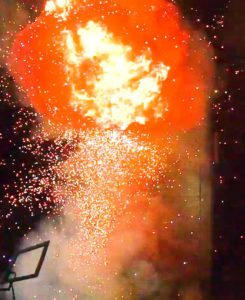This audio was created using Microsoft Azure Speech Services
The impact of a single arc flash event is long-lasting and extends well beyond the split-second incident. In fact, one arc flash can cause serious injuries and interrupt operations for weeks. Other impacts include the cost to replace damaged equipment and repair the facility, and potential harm to a businesses’ reputation.
One way to avoid an arc flash is to choose products and solutions built to reduce the likelihood of an incident. The intentional approach to engineering products and systems to protect workers, equipment, and business from harm caused by an electrical event such as an arc flash is called safety by design.
This blog post highlights four solutions to reduce arc flash incident energy (AFIE) and decrease the severity of an arc flash incident if one occurs.
#1: Reduce Arc Flash Incident Energy with ERMS
Per National Electrical Code section 240.87, any installation rated to 1,200 A or higher must be equipped with a solution that accelerates the clearing time on an arcing fault. An energy-reducing maintenance switch, or setting (ERMS) is one option to meet this code requirement.
When enabled, ERMS provides faster-than-instantaneous clearing times and up to a three-times reduction in arc fault energy. With ERMS, tripping follows a different path than usual so there is no delay before the circuit opens. In effect, the trip happens faster than the instantaneous setting on the usual path of the breaker. After the trip occurs, maintenance workers can then reduce their personal protective equipment by one level when entering the arc flash boundary.
ERMS is made available in Schneider Electric low voltage power equipment by way of MasterPacT™ MTZ circuit breakers. These include the Square D™ Model 6 motor control center (MCC), and the QED-2 SLV switchboard. ERMS modules can also be added to PowerPacT P and R-Frame circuit breakers equipped with P and H MicroLogic™ trip units.
The energy reduction maintenance setting on MasterPacT MTZ circuit breakers can be engaged and disengaged on the MasterPact MTZ mobile app or with an optional, lockable switch installed on the power equipment. When engaged, both the switch and the background on the front-facing digital display turn blue to provide a prominent visual indication that ERMS is activated. PowerPacT-compatible ERMS modules are locally controlled and display a similar blue indicator when enabled.
#2: Keep power on with zone-selective interlocking
Zone selective interlocking reduces tripping time by overriding any intentional delays to rapidly clear faults at a localized point within a coordinated distribution system.
With this reduction solution, the upstream breaker nearest to the fault opens, but all other upstream and downstream breakers remain closed. By isolating the arc fault to a single zone, service remains on and the fault conditions are corrected.
MasterPacT MTZ breakers by Schneider Electric are engineered with zone selective interlocking.
#3: Contain arc flash energy with ArcBlok
ArcBlok™ SML and ArcBlok R help prevent arc flashes and reduce the potentially devastating effects if one occurs in power equipment.
At the center of the ArcBlok system is a fully enclosed cable vault installed at the line-side. The vault prevents debris and accidental contact, which can cause arc flash events. ArcBlok also lowers the AFIE on the line side of overcurrent protective devices to clear faults rapidly. The system also self-extinguishes in less than one cycle to minimize equipment damage and injury to personnel. And with onboard thermal sensing technology, staff are alerted when connections and bus material exceed acceptable thermal parameters, providing time to take corrective measures before more serious conditions develop.
#4: Lower high-voltage energy with transformer disconnects
Per NEC Section 450, all transformers are required to have a main disconnect to turn power on and off. In addition, secondary disconnects that reduce high-voltage energy transmission while maintaining 120V current can also be added. Schneider Electric 9070 transformer disconnects safely reduce AFIE and provide a convenient means of accessing power for auxiliary loads like power tools, panel lighting or any other 120V application in the field or facility. A red indicator light illuminates when the 9070 transformer disconnect is enabled.
Discover more arc flash reduction strategies
Arc flash incident energy reduction is an important component of an overall electrical safety program that incorporates safety by design.
For more information on arc flash avoidance, prevention, containment, and reduction, access this arc flash protection and safety white paper.



